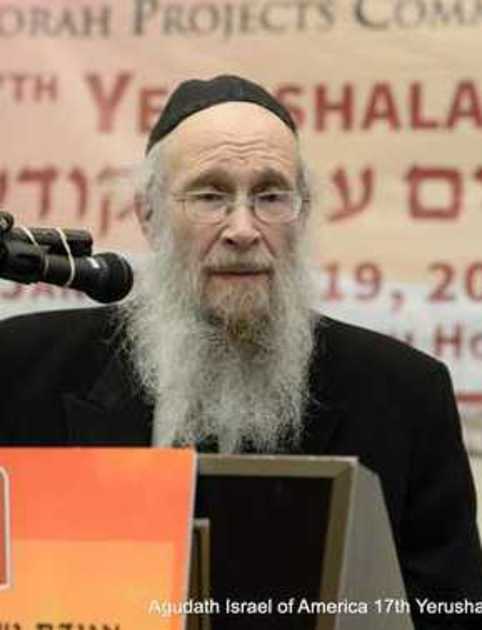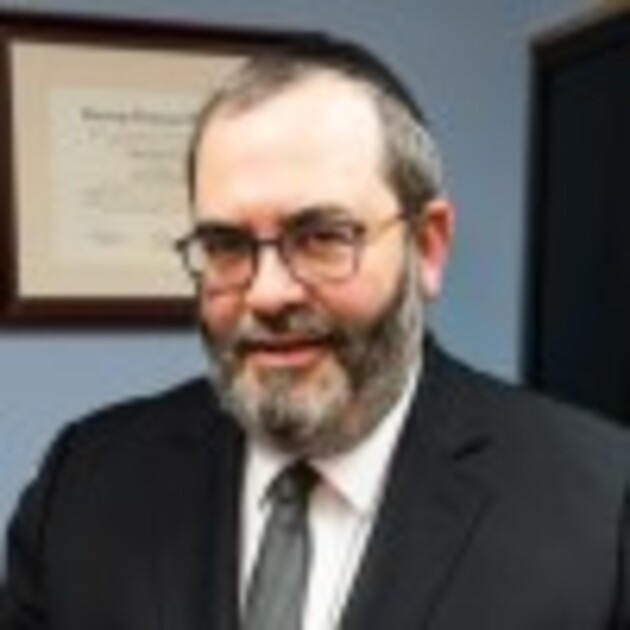
Remarks of Rav Yehoshua Eichenstein at the recent MHP Agudah conference, November 2017.
Words of introduction by Rav Elya Brudny
I would like to introduce Rav Yehoshua Eichenstein who you soon will have the ū¢ūøūĢū¬ of interacting with. I was first introduced to Rav Eichenstein as a 15-year-old 12th grader. At that time, I was learning ūżū©ū¦ ū×ū©ūĢūæūö in Rav Pam’s Shiur at Torah Vodaas. In those years, Yeshiva ended in June and we didn’t finish the perek so Rav Pam took our ū®ūÖūóūĢū© to Camp Morris to finish Meruba. I think that this was 55 years ago in the yearū¬ū®ūø"ūÆ and it was my first experience in Camp Morris. One of the images that remains with me is that of ūÖūöūĢū®ūó ūæū¤ ūĀūĢū¤ ūĀūóū© ū£ūÉ ūÖū×ūÖū® ū×ū¬ūĢūÜ ūöūÉūöū£. The ū®ū¦ūÖūōūö and ūöū¬ū×ūōūö that I remember from Rav Yehoshua, who must have been 20-21 years old at that time, was an incredible sight. And amazingly enough, over the last 7-8 years, I have become involved with him in projects focused on preempting and dealing with many of the challenging issues facing Yeshiva Bochurim today. This began in Eretz Yisroel and is also utilized here in America under an organization called Vaad Chizuk which was founded under the auspices and guidance of Rav Wolbe ū¢"ū£. Rav Yehoshua is someone who is ūøūĢū£ūĢ ū¬ūĢū©ūö. He came from out-of-town (his father was the ū©ūæ ūöūøūĢū£ū£ of St. Louis) to Chaim Berlin and was ū£ūÉ ūÖū×ūÖū® ū×ū¬ūĢūÜ ūöūÉūöū£. He is an example of ūōūóū¬ ū¬ūĢū©ūö: a person who didn’t know anything outside the Daled amos shel halacha. And today he is at the cutting edge among ū©ūÉū®ūÖ ūÖū®ūÖūæūĢū¬ in understanding the general and clinical needs of our young people. So it is a Kiddush Hashem and a unique opportunity to hear from Rav Eichenstein.
Rav Eichenstein
I think that this is a wonderful conference that you have organized. We all know the general problem that exist; we are also all aware of the specific problems of children at risk. And the question is what can we do to assist? I was given a list of 4 questions to discuss and I chose the last one. What is the role of mental health professionals in this problem? What can they do to assist children at risk? Obviously, the first and primary responsibility of a frum mental health professional is to attempt to cure the specific problem that he or she is dealing with. But the question is, can and should we utilize this as an opportunity to attempt to be ū×ū¦ū©ūæ them back to Yiddishkeit. Is our ū¬ūżū¦ūÖūō (role) and our ūÉūŚū©ūÖūĢū¬ (responsibility) limited to nursing them back to emotional health or as professionals who understand properly the ūøūĢūŚūĢū¬ ūöūĀūżū®, can we utilize this understanding to be ū×ū¦ū©ūæ them back to Yiddishkeit? This is what I would like to discuss today.
First, we need to understand why the problem of children-at-risk is so prevalent today. It is obvious to all that this is on the rise. Rav Wolbe used to say that while in the past ūæūŚūĢū©ūÖūØ were made of cardboard, today they are made of paper. And I say that from the times of Rav Wolbe until now, they changed from paper to tissue. People in general are weaker. This itself deserves exploration, but it is a reality.
This weakness of our youth intersects with other realities that cause our youth to struggle with Yiddishkeit and/or go off the ūōū©ūÜ. An important factor is that there is a basic contradiction between the system that we have today (the Yeshivos, bais Yaakovs etc.) and the world around us. Our educational system is rigid; it is built around a framework and one must fit into this framework. This is a complete contradiction to what the world is about today. The world is about instant pleasure and the messages are “do whatever you like, anything is ok, and restrictions are bad.” So, our youth are faced with this contradiction. The Yeshivos and Bais Yaakovs say that you need to be this way and there is no room for deviance, while the outside world projects the message that you should give in to temptation. This all creates an atmosphere ripe for at-risk behavior. Many boys and girls feel that their school (and lifestyle) is a prison, the outside temptations are tremendous, and they are weaker and made of paper.
How then can we deal with this? How can we maintain the ideals of the Yeshiva in today’s climate where the message is one of temptation? If this address was for ū×ūŚūĀūøūÖūØ, we would focus on their role in educating our youth today. But these children are often going to therapists. So the question is, considering the above, what stance should a frum therapist take when interacting professionally with today’s struggling youth? I would like to suggest an approach, which I would only advocate for with appropriate professional backing. Before coming here, I approached Dr. Yitzchok Twersky, a well-known psychologist in Yerushalayim and the famed psychiatrist Dr. Avrohom Yehoshua (AJ) Twerski, the internationally renowned psychiatrist who both agreed with what I am about to say and also gave me some ideas as to how to implement it.
We all know that the Torah is replete with ideas of how to understand people. Prior to the birth of the discipline of psychology, Rav Yisroel Salanter discussed these concepts. Where did Rav Yisroel know psychology from? He knew it from the Torah. The ūøūĢūŚūĢū¬ ūöūĀūżū® of the person are all contained in the Torah. It follows that one who is truly immersed in ū¬ūĢū©ūö and truly comprehends it will understand the ūĀūżū® of the person.
Another relevant point to understand is the following. Rav Yisroel in his letters discussed two approaches in Avodas Hashem: Kibush (constrain and repress) and tikkun (transform or channel). The world today, our so called educational system, is basically built on ideals of Kibush. We create a framework: one must fit into this framework and be koveish (conquer) the desires to leave the framework. Based on the ūżūĪūĢū¦ of ū®ū×ūŚ ūæūŚūĢū© ūæūÖū£ūōūĢū¬ūÖūÜ, Rav Yisroel teaches that for young people, the primary objective should be tikkun and not kibush. This means the desires should not be suppressed, but should be channeled in a positive direction. This is tikkun! People who don’t understand the depth of ūøūĢūŚūĢū¬ ūöūĀūżū® experience difficulty with channeling these drives in a positive direction. But it could and should be done.
Allow me to provide an example of this approach. The ūŚū¢ūĢū¤ ūÉūÖū® in ūÉū×ūĢūĀūö ūĢūæūśūŚūĢū¤ writes that a person must have both ū¬ūóūĀūĢūÆ (pleasure) and ūøūæūĢūō (honor). These are the building blocks of a person. Taanug is obviously a positive force as we know ūöūÉūōūØ ūĀūæū©ūÉ ū£ūöū¬ūóūĀūÆ ūóū£ ūöū®ūØ . Kavod, too, is essential, as ūŚū¢ū£ tell us ūÉūōūØ ūĀūæū©ūÉ ūÖūŚūÖūōūÖ ūæū®ūæūÖū£ ū®ū¬ūÉū×ū© ūæū®ūæūÖū£ūÖ ūĀūæū©ūÉ ūöūóūĢū£ūØ. As the Ramchal explains, every person has their unique duty in his life and no two people who ever existed have the same tafkid. This is a recognition of one’s importance and goals and the ūÖūĪūĢūō of Kavod. Many people may meet their Kavod needs from superficial sources (others telling them how wonderful they are). True Kavod is deeper and a realization of one’s true worth, which ideally is accomplished through Torah, ūÉūÖū¤ ūøūæūĢūō ūÉū£ūÉ ū¬ūĢū©ūö. In any case, the Nefesh Haodam needs sustenance in both Taanug and Kavod. Now, let’s say a bochur feels like he is in prison, has no taanug, no geshmak in learning, and feels like a lo yutzlach. If one doesn’t understand the correct approach in dealing with this, what might they say? Be Kovesh it—just learn and all will work out. ū£ūÉ ū¢ūö ūöūōū©ūÜ—this is not the proper way. The ūōū©ūÜ ūöū¬ūĢū©ūö is one of tikkun. We need to find an approach that will find him both Kavod and Taanug. We will need to build up his ego properly, and only then will we bring him back.
What emerges from the above is the following. Yes, frum mental health professionals need to cure the person. However, your task can be even greater. Since you have a unique understanding of the ūøūĢūŚūĢū¬ ūöūĀūżū® of a person, you can use this understanding to channel the person back to ū¬ūĢū©ūö. Someone may come to you and complain that Yiddishkeit and Torah are confining are restraining. The standard approach is to utilize psychological terminology and psychological concepts to assist this client. While this is indeed very helpful, the result is that the client walks away with the underlying message that while Torah is hurtful, Psychology is helpful and will cure him. The approach that I am suggesting is the following. Take ū×ū¦ūĢū©ūĢū¬ from Chazal to illustrate the exact same concepts that other mental health professionals utilize, but they are derived from the Torah. What does this accomplish? It reconnects the client to Torah at the same time as we are healing them. Instead of thinking that Torah is confining and hurtful and theūŚūøū×ūö ūæūÆūĢūÖūØ ū¬ūÉū×ūÖū¤ of Psychology is what saved me, he now thinks that Torah was his salvation. When this client understands well the concepts brought down in the name of the Chofetz Chaim or from a Sefer on Chassidus, he is reconnected to the Torah. This approach involves using the ideal state-of-the-art treatment, but the terminology is based on Torah sources. Dr. Twersky informed me that this is his standard way of conducting therapy and he is working on a book to illustrate this point.
Dr. Twersky shared with me another thought related to this concept. A few years ago someone approached Rav Elyashiv with the following question. He said that there are tens of thousands of Yiddin who are frequenting 12-step programs, which are derived from Christian and other foreign sources. Is this a trend that we can support? When Rav Elyashiv learned that lives are saved due to this approach, Rav Elyashiv said that people should still be sent there. However, he said that it is preferable for someone to write these concepts from a Torah perspective. This is very consistent with the point that I was emphasizing. We should rewrite psychological concepts from a Torah perspective and work with these concepts professionally (where clinically indicated).
This is my central message. I’d be glad to compile a list or sources for many concepts and discuss this concept more in depth. We have a unique and tremendous role in helping our youth today. We can go down in history as those who saved a generation of youth at risk.
 Previous
Previous

